How to Earn a Featured Snippet | Steps, Tips, and More
Wondering how to earn a featured snippet? We’ve laid out the top tips, steps, and more that you should know in order to try to earn that featured spot on the Google SERP. First, let’s start with the basics.
What is a featured snippet?
By now you’re probably familiar with a featured snippet, but we’ll lay out all of the basics in order to understand how to earn one. A Google featured snippet is what Google deems as the best short answer or piece of content around that particular search query or topic.
Whether you know it or not, you’ve probably seen a number of featured snippets on Google when searching for information or answers to your questions. The position that the featured snippets give to content is often known as “position zero.” The featured snippet, or “answer box” as some people say, takes up the most space on the SERP (Search Engine Results Page). Normally, the featured snippet sits at the very top of the SERP above all of the other links on the page.
Featured snippets are becoming increasingly important today as voice search continues to gain popularity due to programs such as Google Assistant, Siri, and Amazon Alexa which all utilize voice search capabilities. These devices allow users to speak their search queries rather than type them. In fact, 40% of all voice search answers come from featured snippets today. Therefore, earning a featured snippet can prove to be beneficial for not only manual search but voice search as well.
However, it’s important to note that if you’re trying to rank for voice search, you should only try to do so if you’re looking to rank for action-related searches. Google noted that voice queries are 40x more action-oriented than search. Otherwise, though voice search is climbing in popularity, there isn’t too much we can do to optimize for voice search specifically over manual search, unless the query is action-oriented.
Here’s an example of a featured snippet for a question concerning an itchy skin condition:
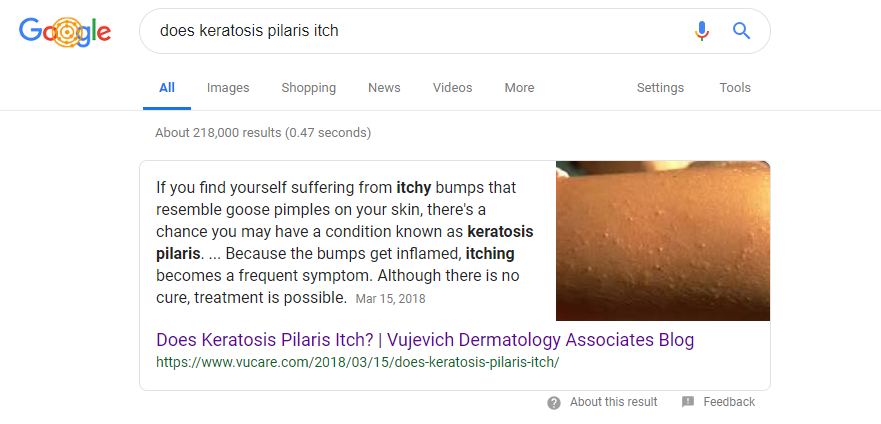
Google usually pulls the featured snippet right from the content that’s already ranking toward the top of page one of the SERP, but it can also pull from lower ranking SERPs. In this case, the content above is also ranking number one organically on the SERP.
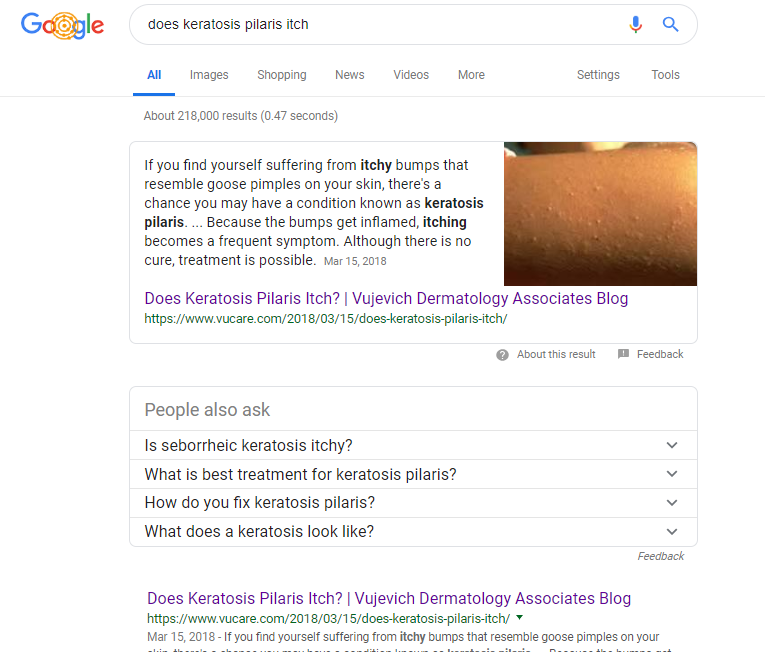
What types of factors affect how to earn a featured snippet?
First and foremost, the quality of your content and the way you format your content matters the most in order to earn a featured snippet. We’ll dive deeper into formatting in the next step. In general, if you’re trying to rank for a featured snippet, you’ll want to create content around answering that search query in an effective and appropriate way. There are, however, some other factors that Google takes into consideration when deciding which piece of content is worthy of that position zero. Included in the list is:
- The speed of your website
- HTTPS – Google wants to see that “s” in your URL which proves that your site is secure
- Domain Authority (DA) – your search engine ranking score that predicts how well a website will rank on a SERP. A Domain Authority score ranges from one to 100, with higher scores corresponding to a greater ability to rank.
Using a combination of all of these factors, Google chooses which page or piece of content is most authoritative and will answer the search query most appropriately.
How do you format your content to earn a featured snippet?
Now that you have a good understanding of featured snippets and all of the factors that Google takes into consideration, it’s important to know how to format your content in a way that will earn the snippet spot.
After analyzing 6.9 million featured snippets and 80 million keywords, SEMrush found that the average featured snippet contains 43-46 words. Ideally, you would want to try to create a paragraph with 43-46 words answering the question or search query that you’re trying to rank for.
Do your research. Whether you use Moz, SEMrush, Quora, or something else to research topics and keywords, it’s important that you know what and how users are searching surrounding the topic you’re writing about.
Other factors to consider are:
- Including headings and subheadings in your content. You can use H1, H2, etc. to include other relevant search queries or important pieces of information on your topic.
- The level of reading you’re writing for. Ideally, you’ll want your content to be for 7th grade level readers. The easier to read the content is, the better chance it has at performing.
- When using images, use landscape images around 600 x 300 px or 600 x 350 px.
- Always include alt text, or alternative text, on your images. Sure, users can generally see the pictures you include on your pages or pieces of content. But alt text, also known as “alt attributes” or “alt descriptions” are used within an HTML code to describe the appearance and function of an image on a page. Simply put, alt text will help tell Google what your image is about.
Different Types of Featured Snippets
You may have noticed that featured snippets often come in different forms, including the standard paragraph, the list, and the table featured snippets. You can format your content based on the type of featured snippet you believe your content would fit into. For example, if you’re writing a piece of content that includes tips or some type of list, you may find that it will be easiest to try to structure your content in a way to get your list to try to rank as a list featured snippet. Here’s a breakdown and example of each type of featured snippet Google can create today:
- Paragraph featured snippet – This one is self-explanatory and may be the type of featured snippet you’ve seen most often. This featured snippet is in the form of a paragraph.
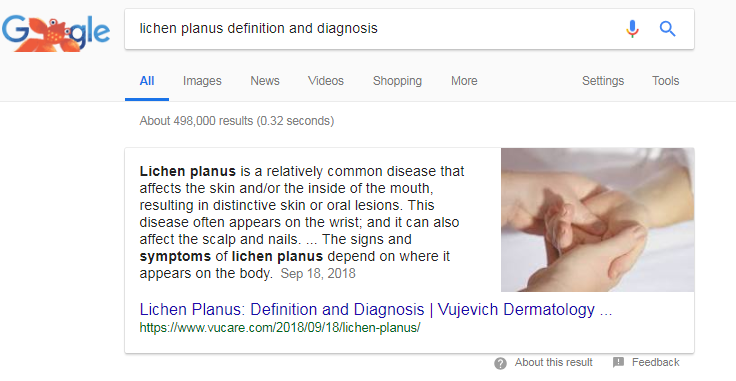
- List featured snippet – the list featured snippet comes in the form of a list. In general, tips, lists, “how to” searches, recipes, etc. tend to rank for list featured snippets. Pro tip: Google shows an average of 5-8 rows in a list featured snippet. So, if you create a list with more than 8 rows (let’s say, “10 tips for Writing a Featured Snippet” for example), Google will not show more than the first 8 rows. Therefore, if you write more than the 8 rows, the user will be more likely to click on your content to see the full amount of content you’ve created to complete that list.
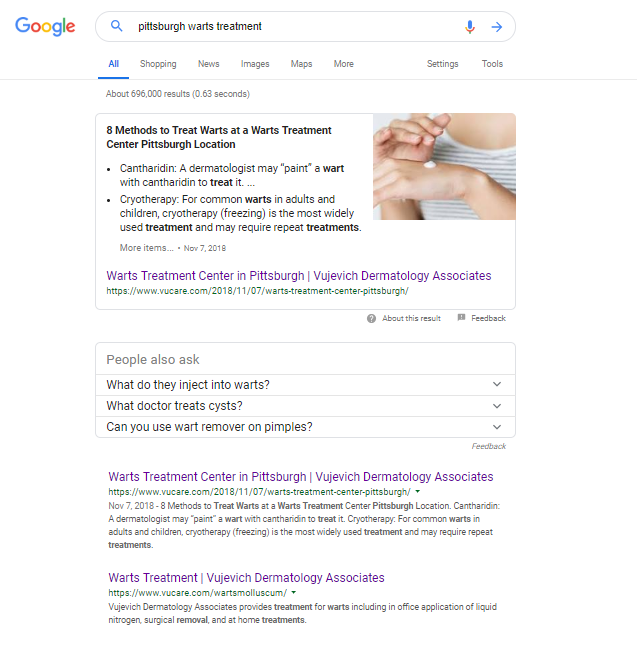
- Table featured snippet – This one is probably the least common featured snippet, but any piece of content trying to rank with a table in their content could try to rank for this type of snippet.
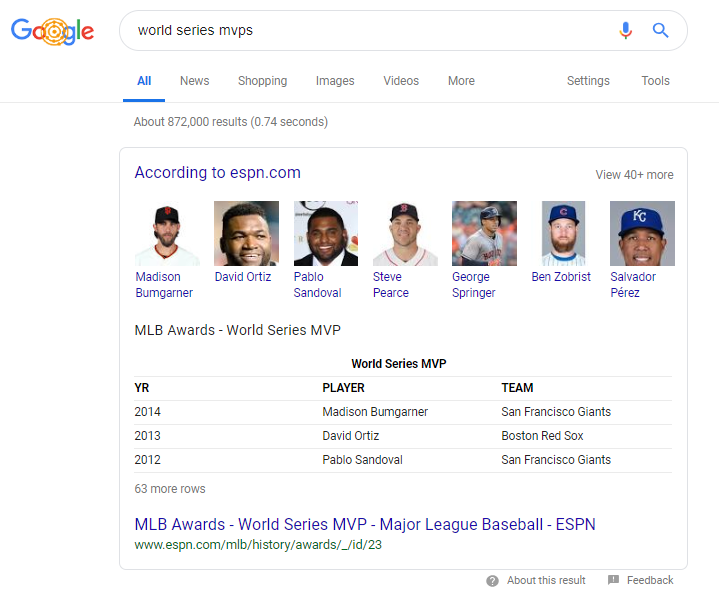
Most common types of search queries that have featured snippets
Hopefully you have a good feel for what featured snippets are, how to earn them, and the different types of snippets available. Now, let’s dive into which types of search queries or keywords most commonly have featured snippets.
- Question featured snippets – these are created using question keywords, such as how, what, who, etc. “How to” search queries often show featured snippets in the SERP. In fact, according to SEMrush, questions show a 480% increase in the percentage of keywords with featured snippets. For example: “how to cook sweet potato fries”
- Preposition featured snippets – These are search queries that include prepositions such as for, like, without, etc. Preposition keywords provide a great opportunity to optimize for an ordered or unordered list featured snippet. For example: “iPhone without SIM card”
- Comparison featured snippets – These are search queries that are used when trying to compare pricing, two products, etc. For example: “princess cut vs. round diamond”
With all this featured snippet knowledge, it’s time to go put it into practice! If you’re interested in further help with featured snippets, just like we helped Vujevich Dermatology earn those featured snippets in the examples in this post, get in touch with us today. You can also learn more about SEO writing like a pro to take your content one step further.
Root & Branch is a boutique digital marketing agency with operations in Pittsburgh, PA and Jacksonville, NC that provides a wide variety of digital advertising and analytics services for B2C and B2B companies. Root & Branch is a certified Google Partner agency and focuses on paid search (PPC), SEO, Local SEO, digital reputation management, digital analytics, and social media management. If interested, you can get in touch or read more about the digital marketing services we offer.





Leave a Reply
Want to join the discussion?Feel free to contribute!